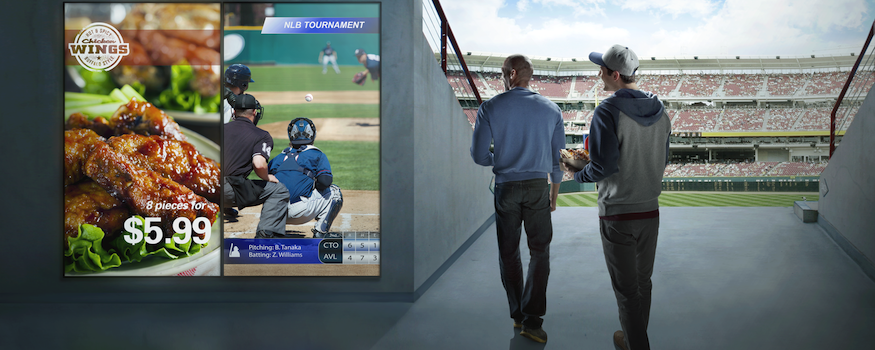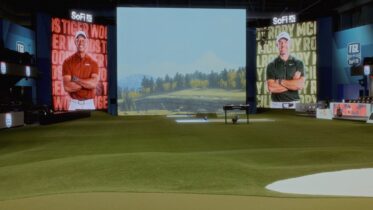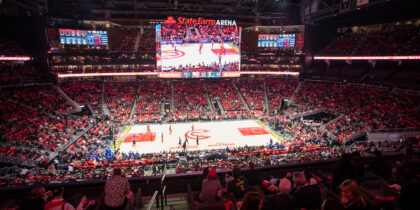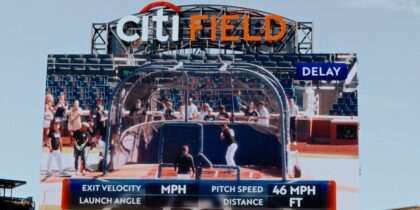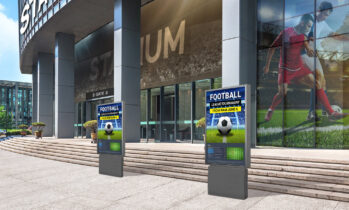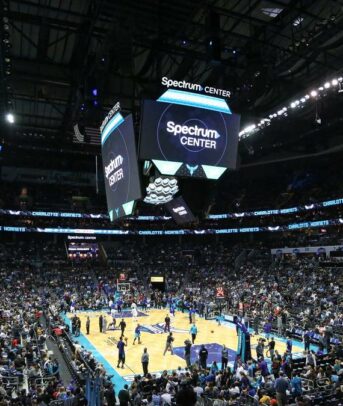High-impact LED scoreboards and replay screens are now as common as hot dog stands in sports venues, but digital signage technology is finding its way into other parts of sports venues to enhance customer experiences and both inform and excite athletes.
In arenas, stadiums and even training centers, LED displays, video walls and 4K LCD screens are being applied in new ways aimed at driving different objectives. In some cases, it’s as simple as venue operators hoping to sell more at their concessions. But screens of all types and dimensions are also being used now behind the scenes, with very different objectives in mind.
Here are four different ways sports signage is being used today:
1. Recruiting
Top high school football stars invited to visit the University of Texas in Austin walk into a training facility where the lockers are topped with flat-panel displays, and the athlete’s photo and stats are displayed. Showcasing that this type of technology awaits them, should they commit to the Texas Longhorns program, can be a draw.
There are rows and rows of the high-tech lockers at the UT facility. The Samsung Smart Signage Platform displays are there throughout the year to visually assign and locate the locker stalls for current players and communicate to them through the training period and active season. But the big driver behind adding networked screens to lockers is to win over the prospects.
“When the recruits are going to see the campus, and they walk into the actual practice facility where they’re going to be spending a large amount of their time, and they see these lockers, and then they see their actual names and their pictures up on the screens, that’s pretty powerful,” says Greg Lewis of PingHD, the Denver-based digital signage software and solutions company whose content management platform is driving the locker screens.
Discover the TCO of Smart Signage
Learn about the cost savings achieved through Samsung's Smart Signage Platform in this white paper. Download Now
“As you can imagine,” continues Lewis, “recruiting is the name of the game for the University of Texas. So they were up front about that being one of the major goals, on top of also being able to use it for a way to communicate with their players directly, whether it’s messaging across all the screens as one big message or having individual players pictures and highlights.”
There are 120 individually addressable Smart Signage displays in the locker room, running off PingHD’s content management platform and operating on built-in media players that use Samsung’s Tizen operating system. The smart displays use HTML5 templates and available player and team data to show content screen by screen, though the platform is designed to allow screens across the full locker room to all show a specific message at the same time.
2. Athlete Communications
Major League Baseball’s New York Mets have numerous screens running different content around the clubhouse areas of Citi Field, the team’s home stadium. Different screens and content channels make players and officials, like the umpires, aware of schedules, weather conditions and even traffic conditions for leaving the stadium.
Stats-crazed baseball is ideally suited for smart displays that can take daily or real-time data and, using HTML5, dynamically show numbers, charts or other graphics. Along with single LCD displays, clubhouse and athletic facility areas are also incorporating digital signage. LCD video walls are a place to show highlights and motivational messaging as well as a screen for players to utilize for entertainment and video games.
3. Making Game Days Better
Detroit-based startup Waittime uses artificial intelligence to interpret data from sensors located around venue concourses and then tell fans, in real-time, where the bathroom and concession lines are shortest during game breaks. Fans get the information from digital signage screens located around the concourse areas, with visual and numeric cues that suggest the wait for beer at one stand is 10 minutes, while another concession stand just around the corner has only a two-minute wait time.
The screens enhance the customer experience by not forcing fans to wait too long and miss game action, and help arena and stadium operators by reducing the numbers of people who take a look at line-ups and return to their seats empty-handed. Concession sales are a big part of sports and entertainment revenues, and every sale counts. The on-screen analytics also serve to load-balance lines around the venue, reducing congestion around the facilities.
4. Premium Viewing Experiences
The National Football League’s Tampa Bay Buccaneers recently brought the experience fans see inside the stadium to the concourse, putting in LED ribbon display boards in a premium ticketholders and VIP section of Raymond James Stadium.
The curved LED screens show key game stats for fans who’ve stepped away from their seats. The West Stadium Club also added a pair of 26×15 ft. video walls at each end, four more smaller video walls above bars and almost 180 4K screens.
It’s clear the sports arenas are data-driven, and digital signage is the perfect technology for getting those stats and visuals in front of fans to enhance the customer experience and drive revenue at the same time.
Digital signage can provide a new level of customer interaction and engagement for your enterprise.
